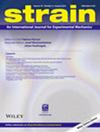基于特征应变的均匀喷丸铝板向轧制方向弯曲的原因分析
IF 1.8
3区 材料科学
Q2 MATERIALS SCIENCE, CHARACTERIZATION & TESTING
引用次数: 0
摘要
本文章由计算机程序翻译,如有差异,请以英文原文为准。
Eigenstrain‐based analysis of why uniformly shot peened aluminium plates bend more in the rolling direction
Shot peen forming is a process widely used to shape aircraft components such as wing skins, yet its fundamental working is still crudely understood. It is understood that a light conventional peen forming treatment applied uniformly over an initially flat plate will induce isotropic in‐plane stretching of the surface layer and will thus lead to a panel curving with identical curvatures in all directions. However, [1] made the startling observation that uniformly peen formed aluminium plates of different aspect ratios all bent along their laminating direction irrespective of the peening direction. This experimental result is counterintuitive because the residual stresses due to the lamination process are 1 order to 2 orders of magnitude smaller than those induced by the shot peen forming treatment. In the present study, we apply the eigenstrain theory to estimate the effect of the different sources of anisotropy on uniformly peen formed aluminium plates. Potential sources of anisotropy included the plastic anisotropy of rolled aluminium, nonequibiaxial initial stresses that redistribute when their equilibrium is disturbed by peening, the geometry of the specimens and externally applied prestress. For the alloy and peening conditions considered, we show that plastic anisotropy had no discernible influence on the resulting shape of the peen formed specimens. Initial residual stresses, on the other hand, caused slightly larger bending loads in the rolling direction of the alloy. Although the magnitude of these loads was approximately 30 times smaller than peening‐induced loads, it was sufficient to overcome the geometric preference for rectangular sheets to bend along their long side and cause all unconstrained specimens to bend along the rolling direction instead. Our analysis highlights the importance of the history of the material that is being peened. Residual stresses already present in the part before peening must be considered to ensure good simulation predictions.
求助全文
通过发布文献求助,成功后即可免费获取论文全文。
去求助
来源期刊

Strain
工程技术-材料科学:表征与测试
CiteScore
4.10
自引率
4.80%
发文量
27
期刊介绍:
Strain is an international journal that contains contributions from leading-edge research on the measurement of the mechanical behaviour of structures and systems. Strain only accepts contributions with sufficient novelty in the design, implementation, and/or validation of experimental methodologies to characterize materials, structures, and systems; i.e. contributions that are limited to the application of established methodologies are outside of the scope of the journal. The journal includes papers from all engineering disciplines that deal with material behaviour and degradation under load, structural design and measurement techniques. Although the thrust of the journal is experimental, numerical simulations and validation are included in the coverage.
Strain welcomes papers that deal with novel work in the following areas:
experimental techniques
non-destructive evaluation techniques
numerical analysis, simulation and validation
residual stress measurement techniques
design of composite structures and components
impact behaviour of materials and structures
signal and image processing
transducer and sensor design
structural health monitoring
biomechanics
extreme environment
micro- and nano-scale testing method.
 求助内容:
求助内容: 应助结果提醒方式:
应助结果提醒方式:


